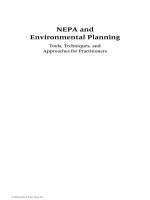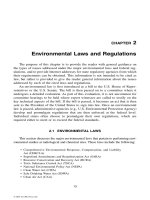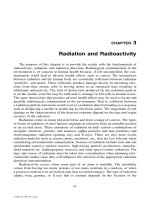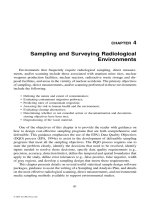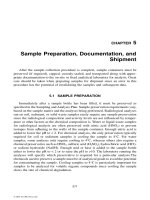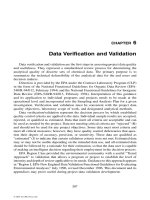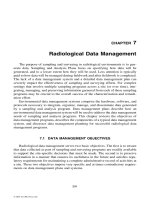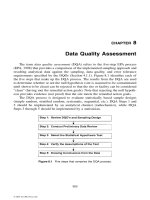Air Sampling and Industrial Hygiene Engineering - Chapter 1 pps
Bạn đang xem bản rút gọn của tài liệu. Xem và tải ngay bản đầy đủ của tài liệu tại đây (407.52 KB, 25 trang )
Air Sampling
and
Industrial Hygiene
Engineering
© 2001 CRC Press LLC
LEWIS PUBLISHERS
Boca Raton London New York Washington, D.C.
Air Sampling
and
Industrial Hygiene
Engineering
Martha J. Boss
and
Dennis W. Day
© 2001 CRC Press LLC
This book contains information obtained from authentic and highly regarded sources. Reprinted material is
quoted with permission, and sources are indicated. A wide variety of references are listed. Reasonable efforts
have been made to publish reliable data and information, but the author and the publisher cannot assume
responsibility for the validity of all materials or for the consequences of their use.
Neither this book nor any part may be reproduced or transmitted in any form or by any means, electronic or
mechanical, including photocopying, microfilming, and recording, or by any information storage or retrieval
system, without prior permission in writing from the publisher.
The consent of CRC Press LLC does not extend to copying for general distribution, for promotion, for creating
new works, or for resale. Specific permission must be obtained in writing from CRC Press LLC for such
copying.
Direct all inquiries to CRC Press LLC, 2000 N.W. Corporate Blvd., Boca Raton, Florida 33431, or visit our
Web site at www.crcpress.com
Trademark Notice: Product or corporate names may be trademarks or registered trademarks, and are used
only for identification and explanation, without intent to infringe.
© 2001 by CRC Press LLC
Lewis Publishers is an imprint of CRC Press LLC
No claim to original U.S. Government works
International Standard Book Number 1-56670-417-0
Library of Congress Card Number 00-048666
Printed in the United States of America 1 2 3 4 5 6 7 8 9 0
Printed on acid-free paper
Library of Congress Cataloging-in-Publication Data
Boss, Martha J.
Air sampling and industrial hygiene engineering / Martha J. Boss, Dennis W. Day.
p. cm.
Includes bibliographical references and index.
ISBN 1-56670-417-0 (alk. paper)
1. Air—Pollution—Measurement. 2. Industrial hygiene. 3. Air sampling apparatus. I.
Day, Dennis W. II. Title.
TD890 .B66 2000
628.5′3′0287—dc21 00-048666
CIP
© 2001 CRC Press LLC
Preface
Many have endeavored to make our outdoor environment cleaner and safer. The learn-
ing process that occurred showed us the limitations of our planet and also the sustainabil-
ity of our ecosystem if given a chance. As a community, we learned about the water, the soil,
and the air. We learned about the underground river that flowed to the surface lake. We
learned about air currents that transported airstreams around our globe. We discovered the
reality of plate tectonics and the ever-changing hydrogeological system. Using this knowl-
edge, we continued to learn how to clean our environment and prevent further damage.
Our science careers began with teaching and working on environmental issues. During
that time our concern for 1 ppm benzene at an underground storage tank (UST) location
was intense. Then as we learned more, we began to see what had been invisible to us
before—the air in our factories, hospitals, schools, homes, and cars. We began to realize that
environmental concerns and our accumulated knowledge on how to protect people and
the environment was not being translated into knowledge about buildings in which peo-
ple live and work. Many people routinely work in factories where exposure to hundreds of
parts per million of benzene is commonplace.
Six years ago we received a call from a farm family in the Midwest. For three genera-
tions they had farmed their land. Now their children, their farm animals, and they them-
selves were sick. A chemical storage fire had burned out of control and covered their land
and homes with oily soot. Yet that spring they planted their fields and tried to live their
lives as before.
As the planting season progressed, farmers sickened in the fields. Upon returning to
their homes, the sickness increased. The vehicles they used in the field became more and
more contaminated. The farmers began buying old cars and abandoning them when they
could ride in them no longer. Two combines were also abandoned. They left their homes,
in some cases the original farm homesteads that had housed three generations.
Planting was over and the hogs were farrowing. The animals were born deformed; the
mother animals died. Eventually most of the animals sickened and were sacrificed. The
farmers began looking for answers.
Fall approached and with that the harvest. The farmers reentered the fields and became
increasingly sick. What to do? Should they even harvest these crops? Should their children
be sent away?
Winter came—was it all in their imagination? The doctors and scientists they had con-
tacted were without answers. Perhaps it would be better in the spring.
Spring arrived, planting began, and the cycle continued. From somewhere, they were
given our name. We arrived and began investigating. These farmers and their families had
not benefited at that time from the collective knowledge available pertaining to fires and
chemical dispersion. Particulates laced with chemicals can exit the periphery of a firestorm.
The chemicals could remain intact or even recombine. Many chemicals can remain in our
soil and water; after plowing with combines, these chemicals reenter the airstream and
become available once again for us to breathe and carry home on our clothing.
These farmers were carrying home the vestiges of chemicals we use as pesticides and
herbicides. Chemicals that had changed in the fire became more toxic at lower levels.
Chemicals were rendered more easily available by their current adsorption to airborne soil
particulates. Upon entry of these particulates into their lungs, the new chemical mix off-
gassed and became biologically active. In the heartland of America, these farmers had
unwittingly participated in an experiment in chemical warfare!
v
© 2001 CRC Press LLC
We decided then to write a book to open a dialogue on air monitoring, risk, and
engineering—a book to show that collectively we as scientists and engineers need to
develop an interdisciplinary approach to applying our knowledge.
Before any art must come the science. Chapter 1 (Air Sampling Introduction), 2 (Air
Sampling Instrumentation Options), and 3 (Calibration Techniques) present the current
state-of-the-art techniques for air sampling. Chapter 4 discusses statistical analysis and rel-
evance issues.
In Chapters 5 (Chemical Risk Assessment) and 6 (Biological Risk Assessment), we dis-
cuss how air sampling and other environmental sampling are used to determine risk—
risks of acute effect, chronic effect, and carcinogenic effect. Biological risk always has the
added element of reproduction, as biologicals, unlike chemicals, can enlarge their numbers
over time and distance from their source.
We then turn our attention to Chapter 7 (Indoor Air Quality and Environments) and
Chapter 8 (Area Monitoring and Contingency Planning). Once we know how to monitor
potential risk, how do we evaluate our buildings, our city air, and all the places we live and
work? What do we do in an emergency? Are there times as illustrated in Chapter 9 when
we will need to use microcircuitry and remote monitoring? What about our workplaces as
addressed in Chapter 10 (Occupational Health—Air Monitoring Strategies)?
Finally we need to consider monitoring for toxicological risk (Chapter 11). If we find
risk is evident, what tools (Chapter 12, Risk Communication and Environmental Moni-
toring) will be needed?
This book is the start of an interdisciplinary look at many issues that in fact are just
one—can we live and work in places that are healthy? Do we have the knowledge and
resources to ensure that our hospitals and schools have clean air? Can we now build and
maintain ventilation systems that do not foul over time?
After World War I, Martha’s grandfather returned to work in a cement plant. He was
having some trouble breathing after he inhaled mustard agent in the trenches of France. At
the cement plant he dug into the earth at a quarry using shovels and eventually powered
equipment. The dust swirled around him and coated his clothing. Every night he was
racked with convulsive coughing. In the morning he felt better, could even smoke on the
way to work. Over the next 30 years, he slowly died. No one knew then to tell him—get
another job, quit smoking, protect your damaged lungs.
Dennis’s father was a plumber. He watched pipe fitters carry buckets of gray slurry to
the work site. The slurry was applied to pipe junctures and hardened to ensure pipe
integrity. The pipe fitters used their hands and wiped the excess slurry on their clothing.
They returned home, where their clothes were washed with their family’s clothes; often the
laundry room was next to the air intake for their home furnace. Over the years Dennis’s
father watched all these men die as their lungs, scarred with asbestosis, failed.
How many men and women to this day still do not know that the factories and work-
places they occupy are poisoning them and often their families? Do they not know because
the knowledge is unavailable? No. However, we have been slow to realize the need to com-
municate our knowledge. The simplest concepts have been lost. You do not have to die to
work. Ventilation systems can be improved. Healthier workers are more productive work-
ers and happier people.
As our buildings age, and as we use ventilation systems designed to heat buildings—
and to cool them—our indoor air problems have multiplied. The heat and cool cycles often
cause condensation within the air-handling systems. The fiberglass duct liners that have
captured particulates become slightly wetted. With time molds and fungi begin their life
cycles hidden from us and amplify in number. Their spores ride the duct’s airstream to our
rooms and hallways. Maintenance personnel cannot reach the biological hiding ground.
© 2001 CRC Press LLC
Our residents begin to notice their health decline. Biological risk? Yes. In our hospitals and
schools? Yes.
Our hope is that this book will be used to begin these dialogues. Engineers and scien-
tists need to look holistically at building design and maintenance. Business people need to
realize the financial risk associated with accepting a nice building front rather than a state-
of-the-art ventilation system. We all need to begin talking and learning together, so that our
children can live and work without concern for the very air that they breathe.
Martha J. Boss
Dennis W. Day
© 2001 CRC Press LLC
About the Authors
Martha Boss is a practicing industrial hygienist and safety engineer living in Omaha,
NE and various airports throughout the United States. Many years ago, Martha won the
Army Science award at the Des Moines, IA science fair. As fate would have it, Martha even-
tually worked for the Army and through the auspices of EPA grants was trained in indus-
trial hygiene. All of this surprised Martha because she had intended to teach high school
science and had prepared herself for that endeavor with a B.A. in biological education
(University of Northern Iowa) and later a BS in biology (University of Nebraska).
During Desert Shield that became Desert Storm, Martha was tasked under the War
Powers Act to assist in the preparation of a western Army base to house and train special
forces. Dennis was also so commissioned, and their professional association began.
Martha worked with her fellow Army industrial hygienists and engineers to assess
biological, radiological, and chemical warfare sites and find solutions. The Army contin-
ued her training at such institutions as Johns Hopkins, Harvard, and other top centers
throughout the nation.
After five years of traveling throughout the country to various very scary places,
Martha decided to settle down in a regional engineering firm. After a couple of years,
Martha realized she did not want to settle down and joined a national engineering firm
where she is employed to this day. Martha is a principal toxicologist for URS Corporation
and continues her practice as a certified industrial hygienist and certified safety profes-
sional (safety engineer). Martha is a member of the Hazardous Substances Research Center
T
3
board for Region 7 of the EPA, a diplomate of the American Academy of Industrial
Hygiene, serves on the editorial advisory board for Stevens Publishing, and is a member of
the American Industrial Hygiene Association and the American Society of Safety
Engineers.
Dennis Day is a practicing industrial hygienist and safety engineer living in Omaha,
NE and various airports throughout the United States. Dennis began his career as a
forester. For several years, he traveled through the forests of the East and South cruising
timber. Then he decided to become a high school science teacher. Dennis used his B.S. in
forestry (University of Missouri) to enable him to pursue additional studies in chemistry
and biology (Creighton University) and become a professional teacher. After teaching for
awhile Dennis was persuaded to join the Army Safety Office and ultimately the Omaha
District engineering division.
Dennis continued for ten years to work with various Army, EPA, and Department of
Defense missions. His work included sites throughout the nation and in Europe. Dennis
concentrated his efforts on streamlining site assessment protocols, community outreach
with protective action plans for chemical warfare sites, and training industrial hygienists
entering the Army work force.
Eventually, Forrest Terrell of Dames & Moore (now URS) convinced Dennis to join that
firm to develop an interdisciplinary industrial hygiene, safety, and engineering service to
commercial and governmental clients. Dennis is a principal toxicologist for URS
Corporation and continues his practice as a certified industrial hygienist and certified
safety professional (safety engineer). Dennis is a diplomate of the American Academy of
Industrial Hygiene and a member of the American Conference of Governmental Industrial
Hygienists, the American Industrial Hygiene Association, and the American Society of
Safety Engineers. In 1992 Dennis received the Achievement Medal for Civilian Service for
his emergency industrial hygiene support following Hurricane Andrew.
© 2001 CRC Press LLC
Contents
1 Air Sampling Introduction
1.1 Documentation
1.2 Sample Documentation
1.3 Competency for Sampling Technicians
1.4 Sampling Activity Hazard Analysis (AHA)
1.5 Security
1.5.1 Sample Containers—Laboratory
1.5.2 Sample Handling and Decontamination
1.5.3 Procedures for Packing and Shipping Low
Concentration Samples
1.5.4 Procedures for Packing and Shipping Medium
Concentration Samples
1.5.5 Chain-of-Custody Records
1.5.6 Mailing—Bulk and Air Samples
1.6 Equipment Precautions
1.6.1 Batteries
1.6.1.1 Alkaline Batteries
1.6.1.2 Rechargeable Nickel-Cadmium (Ni-Cad) Batteries
1.7 Adverse Temperature Effects
1.8 Explosive Atmospheres
1.9 Atmospheres Containing Carcinogens
2 Air Sampling Instrumentation Options
2.1 Volatile Organic Compounds
2.1.1 Photoionization Detector (PID)
2.1.1.1 Calibration
2.1.1.2 Maintenance
2.1.2 Infrared Analyzers
2.1.2.1 Calibration
2.1.2.2 Maintenance
2.1.3 Remote Collection
2.1.4 Oxygen/Combustible Gas Indicators (O
2
/CGI)/Toxin Sensors
2.1.4.1 Remote Probes and Diffusion Grids
2.1.4.2 Calibration Alert and Documentation
2.1.4.3 Alarms
2.1.4.4 Recommendations for Oxygen/Combustible Gas Indicators
2.1.4.5 Relative Response
2.1.4.6 Relative Response and Toxic Atmosphere Data
2.1.4.7 Special Considerations
2.1.4.8 Calibration
2.1.4.9 Maintenance
2.1.5 Oxygen Meters
2.1.6 Solid Sorbent Tubes
2.1.6.1 Calibration Procedures
2.1.7 Vapor Badges
© 2001 CRC Press LLC
2.1.8 Detector Tubes
2.1.8.1 Performance Data
2.1.8.2 Leakage Test
2.1.8.3 Calibration Test
2.1.8.4 Special Considerations
2.1.9 Formaldehyde
2.2 Ozone Meter
2.2.1 Calibration
2.2.2 Maintenance
2.3 Toxic Gas Meters
2.3.1 Calibration
2.4 Semivolatile Organic Compounds (SVOC)
2.4.1 Polynuclear Aromatic Hydrocarbons
2.4.2 Polychlorinated Biphenyls and Creosote
2.4.3 Pesticides and PAHs—PUF
2.5 Acid Gases or Caustics
2.5.1 Impingers
2.5.2 Sorbent Tubes
2.5.3 Detectors
2.5.4 pH Litmus Paper or Meter
2.5.4.1 Calibration
2.6 Mercury Analyzer—Gold Film Analyzer
2.6.1 Jerome Mercury Analyzer
2.6.2 Survey Procedures
2.6.3 Precautions for Area Surveys
2.6.3.1 Calibration
2.6.3.2 Maintenance
2.7 Particulates—Sampled by Filtration/Impaction
2.8 Gravimetric Filter Weighing Procedure
2.9 Total Dust and Metal Fumes
2.10 Respirable Dust
2.10.1 Cyclones
2.10.1.1 Silica Respirable Dust—Cyclone Collection
2.10.1.2 Cyclone Cleaning
2.11 Inhalable Dusts
2.12 Personnel Environmental Monitors (PEMs)
2.13 Welding Fumes
2.14 Asbestos
2.15 Direct-Reading Dust Monitors
2.15.1 Condensation Nuclei Counters (CNCs)
2.15.1.1 Calibration
2.15.1.2 Maintenance
2.15.1.3 Photodetection
2.15.1.4 Calibration
2.15.1.5 Maintenance
2.15.2 Diesel Particulate Matter (DPM)
2.16 Biologicals
2.16.1 General Sampling Protocols
2.16.2 Contact and Grab Sampling
2.16.3 Reuter Central Fugal System (RCS)
© 2001 CRC Press LLC
2.16.4 Exit Requirements
2.16.5 Static Placement Impingement
2.16.6 Bioaerosols
2.17 Radiation Monitors and Meters
2.17.1 Light Meter
2.17.1.1 Calibration
2.17.1.2 Maintenance
2.18 Ionizing Radiation
2.18.1 Ionization Detectors
2.18.1.1 Gas Proportional Detectors
2.18.1.2 Ion Chamber
2.18.1.3 GM Detector
2.18.2 Scintillation Detectors
2.18.3 Counting Efficiency
2.18.4 Monitoring for Radioactive Contamination
2.18.5 Daily Use Checks
2.18.6 Survey Instrument Calibration
2.19 Nonionizing Radiation
2.19.1 Guidance
2.19.2 Broadband Field Strength Meters
2.19.2.1 Calibration
2.19.2.2 Maintenance
3 Calibration Techniques
3.1 Calibration Requirements
3.1.1 Calibration Assurance
3.1.2 Decontamination
3.1.3 Maintenance
3.2 Manual Buret Bubble Meter Technique (Primary Calibration)
3.2.1 Bubble Meter Method
3.3 Electronic Flow Calibrators
3.3.1 Cleaning before Use
3.3.2 Leak Testing
3.3.3 Verification of Calibration
3.3.4 Shipping and Handling
3.3.5 Precautions and Warnings
3.4 Electronic Bubble Meter Method
3.5 Dry Flow Calibration
3.6 Precision Rotameter Method (Secondary)
3.6.1 Replacing the Bubble Meter with a Precision Rotameter
3.7 Span Gas
3.8 Bump Testing
4 Statistical Analysis and Relevance
4.1 Definitions
4.2 Example—Outline of Bulk Sampling QA/QC Procedure
4.3 Example—Outline of the NIOSH 7400 QA Procedure
4.3.1 Precision: Laboratory Uses a Precision of .45
4.3.2 Precision: Laboratory Uses a Precision SR That Is Better Than .45
4.3.3 Records to Be Kept in a QA/QC System
© 2001 CRC Press LLC
4.3.4 Field Monitoring Procedures—Air Sample
4.3.5 Calibration
4.3.6 Negative Air Pressure
4.3.7 Compressor
4.3.8 Recordkeeping and Sample Storage
4.4 Sampling and Analytical Errors
4.4.1 Determining SAEs
4.4.2 Environmental Variables
4.4.3 Confidence Limits
4.5 Sampling Methods
4.5.1 Full-Period, Continuous Single Sampling
4.5.2 Full-Period, Consecutive Sampling
4.5.3 Grab Sampling
4.6 Calculations
4.6.1 Calculation Method for a Full-Period, Continuous Single Sample
4.6.2 Sample Calculation for a Full-Period, Continuous Single Sample
4.6.3 Calculation Method for Full-Period Consecutive Sampling
4.6.4 Sample Calculation for Full-Period Consecutive Sampling
4.7 Grab Sampling
4.8 SAEs—Exposure to Chemical Mixtures
5 Chemical Risk Assessment
5.1 Baseline Risk Assessment
5.2 Conceptual Site Model
5.2.1 Source Areas
5.2.2 Possible Receptors
5.3 Chemicals of Potential Concern
5.4 Human Health BLRA Criteria
5.5 Toxicity Assessment
5.6 Toxicological Profiles
5.7 Uncertainties Related to Toxicity Information
5.8 Potentially Exposed Populations
5.8.1 Exposure Pathways
5.8.2 Sources
5.9 Environmental Fate and Transport of COPCs
5.10 Exposure Points and Exposure Routes
5.11 Complete Exposure Pathways Evaluated
5.12 Ecological Risk Assessment
5.13 Data Evaluation and Data Gaps
5.14 Uncertainties
5.14.1 Uncertainties Related to Toxicity Information
5.14.2 Uncertainties in the Exposure Assessment
5.15 Risk Characterization
5.16 Headspace Monitoring—Volatiles
5.17 O
2
/CGI
5.18 Industrial Monitoring—Process Safety Management
5.19 Bulk Samples
6 Biological Risk Assessment
6.1 Fungi, Molds, and Risk
6.1.1 What Is the Difference between Molds, Fungi, and Yeasts?
© 2001 CRC Press LLC
6.1.2How Would I Become Exposed to Fungi That Would Create
a Health Effect?
6.1.3 What Types of Molds Are Commonly Found Indoors?
6.1.4 Are Mold Counts Helpful?
6.1.5 What Can Happen with Mold-Caused Health Disorders?
6.2 Biological Agents and Fungi Types
6.2.1 Alternaria
6.2.2 Aureobasidium
6.2.3 Cladosporium
6.2.4 Rhodotorula
6.2.5 Stemphylium
6.2.6 Sterile Fungi
6.2.7 Yeast
6.3 Aspergillus
6.3.1 What Color Are These Molds?
6.3.2 How Is Aspergillus Spread?
6.3.3 How Does Aspergillus Grow/Amplify?
6.3.4 What Conditions Help Aspergillus Grow/Amplify?
6.3.5 Can Mold/Fungi Make You Sick?
6.3.6 What Are the Symptoms of Aspergillosis?
6.3.7 Does Aspergillus Cause Deterioration of Materials?
6.3.8 What Happens If Aspergillus Colonies Grow inside
Construction Layers?
6.3.9 How Is Aspergillus Identified?
6.3.10 How Are Levels of Aspergillus Communicated?
6.3.11 Why Do Aspergillus Colonies Look Black?
6.3.12 What Will Biotesting of the Air Show?
6.3.13 What Can Be Done to Prevent Aspergillus Growth?
6.4 Penicillium
6.4.1 What Do Samples Look Like?
6.4.2 What Species of Penicillium Are Used to Produce Antibiotics?
6.4.3 What Other Fungi Grow Where Penicillium Grows?
6.4.4 If Penicillium Grows Everywhere, What Is the Concern?
6.4.5 How Does Penicillium Enter the Body?
6.4.6 Are There Particular Species of Penicillium about Which I
Should Be Concerned?
6.5 Fungi and Disease
6.5.1 Blastomyces dermatitidis
6.5.2 Coccidioides immitis
6.5.3 Histoplasma capsulatum
6.5.4 Sporothrix schenckii
6.5.5 Pathogenic Members of the Genera Epidermophyton,
Microsporum, and Trichophyton
6.5.6 Miscellaneous Molds
6.5.7 Fusarium
6.6 Fungi Control
6.6.1 Ubiquitous Fungi
6.6.2 Infection
6.6.3 Immediate Worker Protection
6.6.4 Decontamination
6.6.5 Fungi and VOCs
© 2001 CRC Press LLC
6.6.6 Controlling Fungi
6.7 Abatement
7 Indoor Air Quality and Environments
7.1 Ventilation Design Guide
7.2 Example Design Conditions Guidance
7.2.1 Outside Design Conditions
7.2.2 Inside Design Conditions
7.3 Mechanical Room Layout Requirements
7.4 Electrical Equipment/Panel Coordination
7.5 General Piping Requirements
7.6 Roof-Mounted Equipment
7.7 Vibration Isolation/Equipment Pads
7.8 Instrumentation
7.9 Redundancy
7.10 Exterior Heat Distribution System
7.10.1 Determination of Existing Heat Distribution Systems
7.10.2 Selection of Heat Distribution Systems
7.10.2.1 AG Systems
7.10.2.2 CST Systems
7.10.2.3 Buried Conduit (preapproved type)
7.10.2.4 Buried Conduit (not preapproved type)
7.10.3 Design of Heat Distribution Systems
7.10.4 Existing System Capacity
7.10.5 General Design Considerations
Identification
7.11 Thermal Insulation of Mechanical Systems
7.12 Plumbing System
7.12.1 Piping Run
7.12.1.1 Back-Siphonage
7.13 Compressed Air System
7.13.1 Compressor Selection and Analysis
7.13.2 Compressor Capacity
7.13.3 Compressor Location and Foundations
7.13.4 Makeup Air
7.13.5 Compressed Air Outlets
7.13.6 Refrigerated Dryer
7.14 Air Supply and Distribution System
7.14.1 Basic Design Principles
7.14.2 Temperature Settings
7.14.3 Air-Conditioning Loads
7.14.4 Infiltration
7.14.5 Outdoor Air Intakes
7.14.6 Filtration
7.14.7 Economizer Cycle
7.15 Ductwork Design
7.15.1 Variable Air Volume (VAV) Systems
7.15.2 Special Criteria for Humid Areas
7.15.3 Evaporative Cooling
© 2001 CRC Press LLC
7.16 Ventilation and Exhaust Systems
7.16.1 Supply and Exhaust Fans
7.16.2 General Items
7.17 Testing, Adjusting, and Balancing of HVAC Systems
7.18 Ventilation Adequacy
7.19 Laboratory Fume Hood Performance Criteria
7.20 Flow Hoods
7.20.1 Calibration
7.20.2 Maintenance
7.21 Thermoanemometers
7.21.1 Calibration
7.21.2 Maintenance
7.22 Other Velometers
8 Area Monitoring and Contingency Planning
8.1 Area of Influence Perimeter
8.1.1 Evaluation of Hazardous Waste/Chemical Risk Sites
8.1.2 Off-Site Characterization before Site Entry
8.1.2.1 Interview/Records Research
8.1.3 On-Site Survey
8.1.3.1 Potential IDLH Conditions
8.1.3.2 Perimeter Reconnaissance
8.1.3.3 On-Site Survey
8.1.4 Chemical Hazard Monitoring
8.1.4.1 Skin and Dermal Hazards
8.1.4.2 Potential Eye Irritation
8.1.4.3 Explosion and Flammability Ranges
8.1.5 Monitoring
8.1.6 Field Logbook Entries
8.1.7 Radiation Monitoring
8.1.7.1 Area Monitoring
8.1.7.2 Contamination Surveys
8.1.7.3 Exposure Rate Surveys
8.1.7.4 Personnel Monitoring
8.2 Evacuation Zones
8.2.1 Emergency Equipment Locations
8.2.2 Site Security and Control
8.2.3 Incident/Accident Report
8.3 Site Work Zone
8.3.1 Integrated Sampling Example
8.3.2 Field QA and QC Example
8.3.3 Invasive Work Sampling Example
8.3.4 Sampling and Initial Site Work Hazard Analysis Example
8.3.4.1 Perimeter Monitoring
8.3.4.2 Air Sampling and Monitoring Example
8.3.4.3 Water Sampling Example
8.3.4.4 Surface Soil/Sediment Sampling Example
8.4 Radiation Sites
8.4.1 Atomic Structure
© 2001 CRC Press LLC
8.4.2 Radioactive Decay
8.4.3 Activity
8.4.4 Decay Law
8.4.5 Half-Life
8.4.6 Types of Ionizing Radiation
8.4.6.1 Alpha Particles
8.4.6.2 Beta Particles
8.4.6.3 Gamma Rays
8.4.6.4 X-rays
8.4.7 Rules of Thumb
8.4.8 Excitation/Ionization
8.4.9 Characteristics of Different Types of Ionizing Radiation
8.4.10 Exposure (roentgen)
8.4.11 Absorbed Dose (rad)
8.4.12 Dose Equivalent (rem)
8.4.13 Effective Dose Equivalent
8.4.14 Biological Effects of Ionizing Radiation
8.4.14.1 Radiosensitivity
8.4.15 Human Health Effects
8.4.15.1 Stochastic Effects
8.4.15.2 Nonstochastic Effects
8.4.16 Determinants of Dose
8.4.16.1 External Exposures
8.4.16.2 Internal Exposures
8.4.17 Sources of Exposure
8.4.17.1 Occupational Exposure
8.4.17.2 Nonoccupational Exposure
8.4.18 Exposure Limits
8.4.19 Basis of Recent Guidelines
8.4.20 Regulatory Limits for Occupational Exposure
8.4.21 Recommended Exposure Limits for Pregnant Workers
8.4.22 Radiation Risk
8.4.23 Philosophy of Current Radiation Safety Practice
8.4.23.1 Internal Radiation Protection
8.4.23.2 Protection against Ingestion
8.4.23.3 Protection against Inhalation
8.4.23.4 Protection against Absorption
8.4.24 External Radiation Protection
8.4.25 Minimizing Exposure Time
8.4.26 Maximizing Distance from Source
8.4.27 Shielding the Source
8.4.28 Emergency Procedures
8.4.28.1 Personal Contamination
8.4.28.2 Minor Spills (Microcurie Quantities of Most Nuclides)
8.4.28.3 For Major Spills (Millicurie Quantities of Most
Nuclides)
9 Microcircuitry and Remote Monitoring
9.1 Continuous IAQ Monitoring in Buildings
9.1.1 IAQ Evaluations
9.1.1.1 Characterization for IAQ Assessment
© 2001 CRC Press LLC
9.1.1.2 Source Assessment and Remediation
9.1.1.3 IAQ Risk Assessment
9.2 Industrial/Remediation Process Monitoring
9.2.1 Process Safety Management Example Scope of Work
9.2.2 Provide List for Hazard and Operability Study
9.2.3 Process Hazard Analysis
9.2.3.1 Hazard and Operability Study
9.2.3.2 Failure Modes and Effects Analysis (FMEA)
9.2.3.3 Fault Tree Analysis
9.2.4 Design Analysis
9.2.4.1 Site Safety and Health Plans
9.2.4.2 Health and Safety Design Analysis (HSDA)
9.2.4.3 Drawings
9.2.4.4 Specifications
9.2.4.5 Design Analysis Example—Wastewater Treatment
10 Occupational Health—Air Monitoring Strategies
10.1 Exposure Measurements
10.2 STEL Sampling
10.3 Exposure Fluctuations
10.4 Air-Sampling Pump User Operation
10.4.1 Pump Donning
10.4.2 Pump Checking
10.4.3 Pump Doffing
10.5 Air Sampling—Asbestos
10.5.1 Sampling Prior to Asbestos Work
10.5.2 Sampling during Asbestos Abatement Work
10.5.3 Sampling after Final Cleanup (Clearance Sampling)
10.5.4 NIOSH Method
10.5.5 Air Sampling Documentation
10.5.6 Asbestos Exposure Monitoring (29 CFR 1910.1001 and
29 CFR 1926.1101)
10.5.7 Initial Monitoring
10.5.8 Historical Documentation for Initial Monitoring
10.5.9 Objective Data for Initial Monitoring
10.6 Crystalline Silica Samples Analyzed by X-Ray Diffraction (XRD)
10.6.1 Air Samples
10.6.1.1 Laboratory Results for Air Samples
10.6.2 Bulk Samples
10.6.3 Sample Calculations for Crystalline Silica Exposures
10.6.4 Sample Calculation for Silica Exposure
10.7 Metals—Welding
10.8 General Technique for Wipe Sampling
10.8.1 Filter Media and Solvents
10.8.2 Wipe Sampling Procedures
10.8.3 Special Technique for Wipe Sampling with Acids and Bases
10.8.4 Direct-Reading Instruments
10.8.5 Aromatic Amines
10.8.6 Special Considerations
10.8.6.1 Fluorescent Screening for Carcinogenic Aromatic Amines
10.8.6.2 Alternate Screening Methods for Aromatic Amines
© 2001 CRC Press LLC
11 Monitoring for Toxicological Risk
11.1 Types of Sampling
11.1.1 Long-Term Samples
11.1.2 Short-Term Samples
11.1.3 Area Samples
11.1.4 Wipe Samples
11.2 Quality Control
11.3 Exposure Evaluation Criteria
11.4 Examples of Chemicals That Require Monitoring
11.4.1 Carbon Monoxide (CO)
11.4.2 Hydrogen Sulfide (H
2
S)
11.4.3 Sulfur Dioxide (SO
2
)
11.4.4 Ammonia (NH
3
)
11.4.5 Benzene
11.4.6 Hydrogen Cyanide or Hydrocyanic Acid (HCN)
11.4.7 Lead
11.4.8 Flammable Chemicals
11.4.9 Reactive Hazards—Oxidizers
11.4.10 Paint
11.4.11 Cleaning Supplies
11.4.12 Compressed Gases
11.5 Confined Space Monitoring
11.5.1 Entry Permits
11.5.2 Bump Testing
11.5.3 Monitoring for LEL and O
2
Levels
11.5.4 Isolation
11.5.5 Confined Space—Cautionary Statements
11.5.6 Stratified Atmospheres
11.6 Welding
11.6.1 Effects of Toxic Gases
11.6.2 Ventilation
11.6.3 Ventilation in Confined Spaces during Welding
11.6.4 Fume Avoidance
11.6.5 Light Rays
11.6.6 Infrared Rays
11.6.7 Noise
11.6.8 Gas Welding and Cutting
12 Risk Communication and Environmental Monitoring
12.1 Federal Legislation
12.1.1 The Clean Air Act Amendments of 1990 (CAAA90)
12.1.2 The Federal Water Pollution Control Act.
12.1.3 Resource Conservation and Recovery Act (RCRA) of 1976
12.1.4 State/Local Regulations
12.2 Key Compliance Requirements
12.2.1 Steam-Generating Units [greater than 29 MW (100 MBtu/h)]
12.2.2 Steam-Generating Units [2.9 MW (10 MBtu/h) to 29 MW]
12.2.3 Fuel-Burning Facilities
12.2.4 Stationary Gas Turbines
12.2.5 Municipal Waste Combustor
© 2001 CRC Press LLC
12.2.6 Incinerators
12.2.6.1 Sewage Sludge Incinerators
12.2.6.2 Beryllium Incinerators
12.2.6.3 Incineration of Sewage Sludge
12.2.7 Gasoline Dispensing
12.2.8 Rotogravure Printing Presses
12.2.9 Fugitive Emissions
12.2.10 Sulfuric and Nitric Acid Plants
12.2.11 CFCs and Halons
12.2.12 Degreasing Operations
12.3 Key Compliance Definitions
12.4 Community Relations
12.4.1 Notification
12.4.2 Fact Sheets
12.4.3 Explaining Air Monitoring to the General Public
12.4.4 Employee Education
12.4.5 Public Accessibility
12.4.6 Repository
12.4.7 Dialogue
Glossary of Terms
© 2001 CRC Press LLC
CHAPTER 1
Air Sampling Introduction
This chapter provides an overview of air sampling and site monitoring that is legally defensible.
It answers questions about monitoring protocols that must be initiated for emergency and contin-
gency situations.
1.1 DOCUMENTATION
Essentially in any sampling endeavor, without documentation, you have what is called
“personal opinion.’’ The intent of documentation is to provide the basis for professional
opinion. The documentation then becomes a dialogue of historical perspective and the
empirical sampling event.
When assembling historical documentation, make sure that you define how the infor-
mation is used. Often in order to understand sampling results, the environment, including
work practices, must be analyzed. Work practices include human factors; therefore, you must
be very careful to present a dialogue of these work practices that is not individually invasive.
When you decide on documentation techniques, before you write the first chronicle,
enter field notes, or take that first picture, make sure that everyone understands what the
purpose of the information is and who will have access to this information.
Be very careful when the original scope of work calls for only general information.
Often as the investigation continues, you may be asked to provide very specific reasons for
general information development. Consequently, even for general information screening
or limited audits, you may need to keep very specific information available to substantiate
your opinions.
Whenever a review of human factors is required, especially interviews, all parties must
understand the limitations on personal anecdotal information. If you do not intend to per-
sonally name the interviewee, make sure all parties understand.
The overriding message here is define your scope of work and write this definition for
all to see. If you need to work under the auspice of attorney/client privilege or through any
other set boundaries, make sure the scope of work reflects these facts.
1.2 SAMPLE DOCUMENTATION
To assist in determining appropriate engineering controls, take photographs (as appro-
priate) and detailed notes concerning the following:
© 2001 CRC Press LLC
• Visible airborne contaminants
• Work practices
• Potential interferences
• Movements
• Other conditions
Prepare blanks during the sample period for each type of sample collected. One blank will
suffice for up to 20 samples for any given analysis. These blanks may include opened, but
unused, charcoal tubes.
1.3 COMPETENCY FOR SAMPLING TECHNICIANS
When deciding who is defined as a competent sampling technician, the first criterion
is as follows: Is the scope of work completely defined according to sampling requirements?
If you have any doubts about the situation with which samplers are involved, whether
those doubts stem from a lack of background knowledge of the site or unknown hazards,
the sampling scope is not completely defined.
For undefined sampling scopes, a senior sampling professional will need to initiate the
site work. If the sampling choices once in the field are multifactorial, in that circumstances
on-site are very dynamic, a team of senior sampling professionals is required.
Remember that a phenomenon known as perceptual shift will occur during sampling.
As we become more or less secure with our environment, we start to see things differently.
A strong team is able to keep its members on target, thus providing a more complete pic-
ture of the sampling environment.
Once a scope of work is defined, sampling can often be delegated to less senior per-
sonnel. The purpose of this text is to provide information to assist in the standardization of
both the initial and the delegated work effort. Despite the many ways of communicating
before the sampling event, dialogue must be continued throughout the sampling event.
Unfortunately this dialogue may not be free-flowing conversation without limitations. The
original team that defined the scope of work must be available to the on-site personnel. The
actual conversations on-site, while delimited by many events, must give way to free-
flowing discussions within this team so that the collected data are useful and relevant.
1.4 SAMPLING ACTIVITY HAZARD ANALYSIS
To analyze the activities involved in sampling, an Activity Hazard Analysis (AHA)
may be required. An example AHAis given in Table 1.1.
1.5 SECURITY
Whenever confidential or security issue data are collected, this information must be
secured. One of the most difficult issues when on-site is just what to write down or record
on media. Too much information is as bad as too little information.
For the junior sampling technician, raw data should not be interpreted in the field
without consultation with the scope development team. Usually this consultation will pro-
duce advice to the sampling technician; do not record that advice other than through a ver-
bal discussion with senior staff.
© 2001 CRC Press LLC
Table 1.1 Air Sampling and Monitoring
Activity Hazards Recommended Controls
Air sampling and Electrical
• Grounded plugs should be used.
monitoring
• Generators or air pumps should be used in dry areas,
away from possible ignition sources.
• Do not stand in water or other liquids when handling
equipment.
• Electrical equipment will conform to OSHA
1910.303(a) and 1910.305(a),(f),(f)(3).
• Ground fault interrupters are used in the absence of
properly grounded circuitry or when portable tools
must be used in wet areas.
• Extension cords should be protected from damage
and maintained in good condition.
Sampling pumps
• Air pumps should be placed within easy reach using
Ambient an OSHA-approved ladder or elevated platform or by
environment placing the pump on a stake.
and readings
• Personnel should be thoroughly familiar with the use,
limitations, and operating characteristics of the
monitoring instruments.
• Perform continuous monitoring in variable
atmospheres.
• Use intrinsically safe instruments until the absence of
combustible gases or vapor is anticipated.
Samples should be handled only by workers specifically designated as samplers. The
worker who signs the chain-of-custody record will guarantee sample integrity until its final
arrival at the laboratory.
1.5.1 Sample Containers—Laboratory
The analytical laboratory will often provide sample containers. The containers for soil
or water sampling will be either high-density polyethylene or glass with Teflon
®
-lined lids
and will be pretreated with preservatives as applicable. The type of sample containers and
preservatives required for each analysis will be specified by the laboratory in coordination
with the scope of work.
Sample filter cassettes, sorbent tubes, and other collection devices for air samples may
also be obtained for the laboratory. Coordination with the laboratory is essential to ensure
that sample containers meet the laboratory’s internal quality control requirements as well
as regulatory requirements.
1.5.2 Sample Handling and Decontamination
After sample collection in the field, the exterior of sample containers will be decontam-
inated if gross contamination is present. The sample containers will be handled with gloves
until they are decontaminated with a detergent wash and water rinse. Care will be taken to
avoid damaging the temporary labeling during decontamination. After decontamination,
permanent labels will be placed on clean sample container exteriors.
© 2001 CRC Press LLC
The sample containers will be well cushioned with packing materials and packaged as
described below for transportation to the laboratory. Care will be taken to seal bottle caps
tightly. The samples will be shipped to the laboratory under chain-of-custody protocols.
Asbestos samples should never be sent with packing peanuts because the static charge
generated during shipping will alter the pattern of fiber deposition on the cassette filters.
Volatile samples must be sent in cooling chests to maintain a 4°C atmosphere during ship-
ment. Semivolatiles should also be sent in cooling chests.
1.5.3 Procedures for Packing and Shipping Low
Concentration Samples
Samples will be packaged as follows:
• Use waterproof metal (or equivalent strength plastic) ice chests or coolers only.
• After determining the specific samples to be submitted and filling out the perti-
nent information on the sample label and tag, put the label on the bottle or vial
prior to packing.
• Secure the lid with strapping tape (tape on volatile organic compound [VOC]
vials may cause contamination).
• Mark volume level on bottle with grease pencil.
• Place about 3 in. of inert cushioning material, such as vermiculite, in the bottom
of the cooler.
• Enclose the bottles in clear plastic bags through which sample tags and labels are
visible and seal the bags. Pack bottles upright in the cooler and isolate them in
such a way that they do not touch and will not touch during shipment.
• Place bubble wrap and/or packing material around and among the sample bot-
tles to partially cover them (no more than halfway).
• Add sufficient ice (double bagged) between and on top of the samples to cool them
and keep them at approximately 4°C until received by the analytical laboratory.
• Fill cooler with cushioning material.
• Put paperwork (chain-of-custody record) in a waterproof plastic bag and tape it
with duct tape to the inside.
• Tape the drain of the cooler shut with duct tape.
• Secure the lid by wrapping the cooler completely with strapping, duct, or clear
shipping tape at a minimum of two locations. Do not cover any labels.
• Attach completed shipping label to the top of the cooler.
• Label “This Side Up’’ on the top of the cooler, “Up’’ with arrow denoting direc-
tion on all four sides, and “Fragile’’ on at least two sides.
• Affix numbered and signed custody seals on front right and back left of cooler.
Cover seals with wide, clear tape.
1.5.4 Procedures for Packing and Shipping Medium
Concentration Samples
An effort will be made to identify samples suspected of having elevated contaminant
concentrations based on field observations and screening tests. These samples will be seg-
regated and packed in a separate container to the extent allowed by prevailing field con-
ditions. Lids for these samples will be sealed to the containers with tape. Medium
© 2001 CRC Press LLC
concentration samples will be packed in the same manner as described for low concentra-
tion samples.
1.5.5 Chain-of-Custody Records
Chain-of-custody protocols will be established to provide documentation that samples
were handled by authorized individuals as a means to maintain sample integrity. The
chain-of-custody record will contain the following information:
• Sample identification number
• Date, time, and depth of sample collection
• Sample type (e.g., sludge)
• Type and number of container
• Requested analyses
• Field notes and laboratory notes
• Project name and location
• Name of collector
• Laboratory name and contact person
• Signature of person relinquishing or receiving samples
Chain-of-custody records will be maintained for each laboratory sample. At the end of
each day on which samples are collected, and prior to the transfer of the samples off-site,
chain-of-custody documentation will be completed for each sample. Information on the
chain-of-custody record will be verified to ensure that the information is consistent with
the information on the container labels and in the field logbook.
Upon receipt of the sample cooler at the laboratory, the laboratory custodian will break
the shipping container seal, inspect the condition of the samples, and sign the chain-of-
custody record to document receipt of the sample containers. Information on the chain-of-
custody record will be verified to ensure that the information is consistent with the
information on the container labels. If the sample containers appear to have been opened
or tampered with, this discrepancy should be noted by the person receiving the samples
under the section entitled “Remarks.’’ The completed chain-of-custody records will be
included with the analytical report prepared by the laboratory.
1.5.6 Mailing—Bulk and Air Samples
Mail bulk samples and air samples separately to avoid cross-contamination:
• Pack the samples securely to avoid any rattle or shock damage. Do not use
expanded polystyrene packaging.
• Use bubble sheeting as packing.
• Put identifying paperwork in every package.
• Do not send samples in plastic bags or envelopes.
• Do not use polystyrene packing peanuts.
• Print legibly on all forms.
For exceptional sampling conditions or high flow rates, contact a Certified Industrial
Hygienist (CIH) or the chosen analytical laboratory (approved by the American Industrial
Hygiene Association [AIHA]).
© 2001 CRC Press LLC
1.6EQUIPMENT PRECAUTIONS
1.6.1BATTERIES
1.6.1.1Alkaline Batteries
Replace frequently (once a month) and carry fresh replacements.
1.6.1.2Rechargeable Nickel-Cadmium (Ni-Cad) Batteries
Check the batteries under load (e.g., turn pump on and check voltage at charging jack)
before use. See the manufacturer’s instructions for locations to check voltage. Use 1.3 to 1.4 V
per Ni-Cad cell for an estimate of the fully charged voltage of a rechargeable battery pack.
It is undesirable to discharge a multicell Ni-Cad battery pack to voltage levels that are
70% or less of its rated voltage; this procedure will drive a reverse current through some of
the cells and can permanently damage them. When the voltage of the battery pack drops
to 70% of its rated value; it is considered depleted and should be recharged.
Rechargeable Ni-Cad batteries should be charged only in accordance with the manu-
facturer’s instructions. Chargers are generally designed to charge batteries quickly
(approximately 8 to 16 h) at either a high charge rate or slowly (trickle charge). Abattery
can be overcharged and ruined when a high charge rate is applied for too many hours.
However, Ni-Cad batteries may be left on trickle charge indefinitely to maintain them at
peak capacity. In this case discharging for a period equal to the longest effective field serv-
ice time may be necessary, because of short-term memory imprinting (Figure 1.1).
Figure 1.1 This battery maintenance system accommodates one to five rechargeable air sampling
pump battery packs. (SKC)
© 2001 CRC Press LLC
1.7 ADVERSE TEMPERATURE EFFECTS
High ambient temperature, above 100°F and/or radiant heat (e.g., from nearby molten
metal) can cause flow faults in air sampling pumps. If these conditions are likely, use the
pump with a higher operating temperature range (e.g., Dupont Alpha-1) as opposed to a
pump with a lower operating temperature range (e.g., SKC).
1.8 EXPLOSIVE ATMOSPHERES
Instruments must not be used in atmospheres where the potential for explosion exists
(29 CFR 1910.307). Instruments must be intrinsically safe and certified by the
• Mine Safety and Health Administration (MSHA)
• Underwriter’s Laboratory (UL)
• Factory Mutual (FM)
• Other testing laboratories recognized by the Occupational Safety and Health
Administration (OSHA)
When batteries are being replaced, use only the type of battery specified on the safety
approval label.
Do not assume that an instrument is intrinsically safe. If you are uncertain, verify its
safety by contacting the instrument’s manufacturer.
1.9 ATMOSPHERES CONTAINING CARCINOGENS
A plastic bag should be used to cover equipment when carcinogens are present.
Decontamination procedures for special environments should be followed after using
equipment in carcinogenic environments.
© 2001 CRC Press LLC

